Understanding Cat Nail Scratchers: A Comprehensive Guide
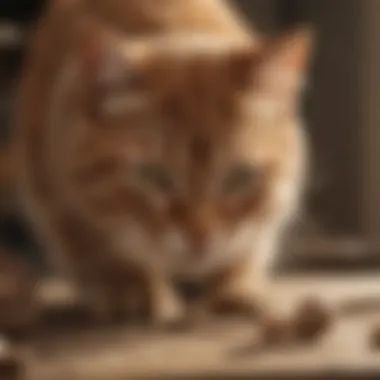

Intro
Understanding the nuances of cat nail scratchers is essential for every feline owner. Cats have an intrinsic need to scratch, a behavior that stems from both natural instinct and psychological necessity. This article aims to illuminate the intricacies surrounding cat scratchers, discussing why they are vital for your cat's health and behavior. We will explore various types, suitable materials, and designs that cater to specific scratching habits, along with tips on selection and maintenance.
A well-chosen scratcher serves more than functional purposes. It can prevent destructive behavior, support healthy claws, and even provide an outlet for stress relief. As we delve deeper into this subject, pet owners will gain a well-rounded comprehension of how nail scratching contributes to a cat's wellbeing.
Pet Care and Grooming
Importance of Regular Care
Regular grooming enhances your cat’s hygiene and well-being. Scratching is a vital part of a cat’s self-care routine. By encouraging the right use of scratchers, owners can help their cats maintain healthy claws. This practice not only aids in keeping your home intact but also prevents potential health issues such as claw overgrowth or injury.
Grooming Techniques by Pet Type
Different breeds have varying grooming needs. Long-haired breeds often require more upkeep to prevent matting. For these cats, integrating scratching as a grooming method can be particularly helpful. Engaging your cat with his preferred scratching surface helps remove dead material from claws and can aid in reducing excess shedding.
Tools and Products Recommendations
When selecting grooming tools, consider these recommendations:
- Nail clippers for pets: A reliable choice to keep claws at an ideal length.
- Slicker brushes: Effective for removing loose fur, especially for long-haired cats.
- Scratchers: Various shapes and materials like cardboard, sisal, or carpet should be available.
Seasonal Care Tips
Cats may require different care depending on the season. During shedding periods, regular grooming is essential. Ensure that there are scratchers available to facilitate this natural behavior, especially if your cat is an indoor pet. Owners should also monitor their cat’s claw condition, as seasonal changes may influence claw growth rate and health.
Health and Nutrition
Understanding Pet Nutrition
Nutrition plays a crucial role in overall health. Cats need a balanced diet rich in protein and essential nutrients. Proper nutrition supports healthy skin and nails, thus influencing the significance of their scratching habits. High-quality cat food contributes to less frequent claw filling, and this can minimize the need for excessive scratching.
Common Health Issues by Species
Cats may face various health issues if proper care is neglected. Soft claws and cracked nails can arise from lack of appropriate scratching surfaces. Regular checks on claw condition should be part of a routine health evaluation for owners.
Preventive Care and Regular Check-Ups
Routine veterinary visits are vital. By having regular health check-ups, owners can catch any early signs of claw-related issues. Being proactive can often prevent more severe complications later on.
Food and Dietary Advice
Understanding your cat's dietary needs is essential. Owners should aim for balanced meals that support health. Consulting with a veterinarian can guide you in choosing the right food options that mirror your cat’s lifestyle and health requirements.
Behavioral Training
Basics of Positive Reinforcement
Understanding your cat’s psychology can significantly improve interactions. Positive reinforcement encourages desired scratching behavior on scratchers rather than furniture. Rewarding your cat for using the scratcher can help develop good habits.
Training Techniques Users Can Apply
Several techniques can be effective:
- Redirecting: If a cat scratches furniture, redirect to a scratcher.
- Claw trimming: Regular trimming can prevent overgrowth and scratching problems.
- Consistency in training: Consistency reinforces the learning process.
Managing Behavioral Issues
Identifying why a cat scratches can help in managing behavior. Stress or boredom can often lead to excessive scratching. Offering engaging activities or additional scratchers can alleviate such issues.
Importance of Socialization
Socialization contributes to a cat’s overall mental health. Engaging with your cat helps develop a bond, making behavioral training more effective. Regular social interaction can encourage positive scratching habits.
Engaging Activities and Enrichment
Fun Games to Play with Your Pet
Interactive play is crucial for mental stimulation. Engage your cat with chasing games or use feather wands. Such activities can divert attention from destructive scratching.
DIY Toys and Activities
Creating homemade toys can be quite simple. Using basic materials to craft a scratching post or interactive toy can be fulfilling for both you and your cat. Consider recycling cardboard boxes for this purpose.
Importance of Mental Stimulation
Providing mental stimulation is essential for a happy and healthy cat. Scratchers can be integrated into playtime, providing mental and physical challenge.
Outdoor Adventures and Exploration
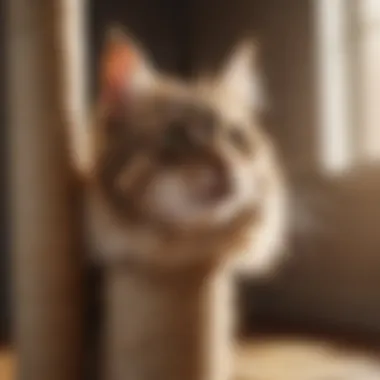
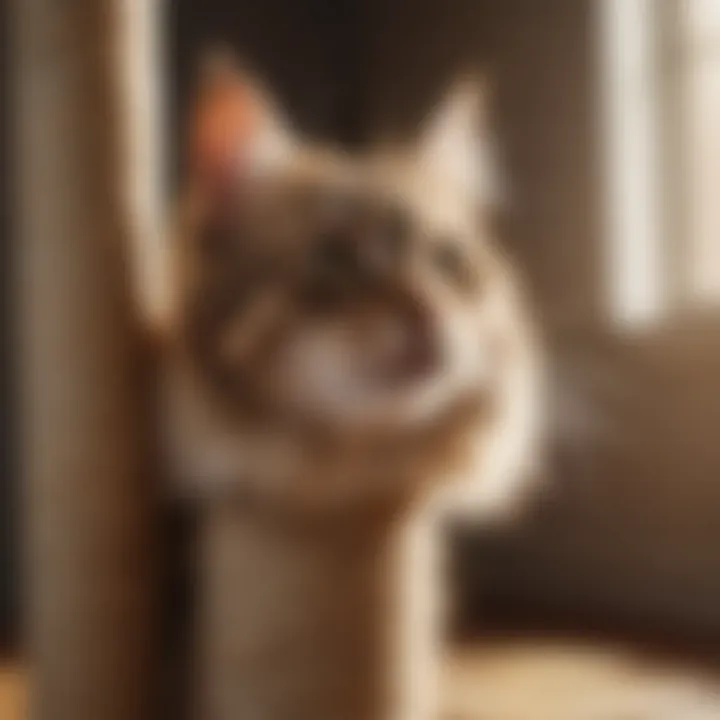
If possible, allow your cat safe outdoor access. Harness training can offer enrichment while managing safety. Exploring new environments satisfies instinctive behaviors, reducing the likelihood of destructive scratching.
Resources and Community Engagement
Recommended Books and Websites
Consider resources like Wikipedia and Britannica for further reading. These platforms offer extensive information on feline behavior and care.
Forums and Groups for Pet Owners
Online forums, such as Reddit, provide community engagement. Discussions in these groups can offer valuable insights and tips from fellow cat owners.
Finding Local Services and Classes
Pet owners may find classes beneficial for training and socializing their cats. Local animal shelters and community centers often host events tailored to enhance pet care practices.
Encouraging Community Sharing and Contributions
Encourage sharing experiences and resources within your community. It promotes awareness and education on proper cat care, benefitting all involved.
Understanding and respecting our cats’ needs is crucial to create a harmonious living environment.
Prelude to Cat Nail Scratchers
Nail care for cats is often underestimated by pet owners. Many see it as a simple grooming procedure but, in truth, it plays a vital role in their overall well-being. Cat nail scratchers serve both functional and behavioral needs that are crucial for a cat's health. Understanding their significance enables owners to make informed decisions which benefit their feline companions.
Significance of Nail Care for Cats
Nail care is essential for several reasons. Firstly, it helps prevent unwanted scratching of furniture and human skin. Cats naturally have the urge to scratch, and providing them with appropriate outlets is key. Regular scratching maintains their claws, keeping them trimmed and preventing painful overgrowth.
Additionally, nail care contributes to physical health. Scratching helps to shed old claw sheaths, allowing healthier nails to grow. It also promotes healthy paw pads through exercise and stretching, which reduces the risk of injury or infection. Furthermore, maintaining their claws reduces the chances of accidents — for both the cat and the owner.
Understanding Scratching Behavior
Scratching is an instinctive behavior in felines. Many factors influence a cat's need to scratch, most notably territory and stress. By scratching, cats mark their territory with scent glands located in their paws. This behavior sends signals to other animals, defining their space.
Behavioral studies show that scratching can also be a response to stress and anxiety. Cats often scratch to relieve tension or frustration. Providing them with an appropriate scratching surface can help to alleviate these feelings, promoting mental well-being. Understanding the motivations behind scratching can help owners create an environment that respects their pet's needs while protecting household items.
Types of Cat Nail Scratchers
Understanding the types of cat nail scratchers is vital for pet owners seeking to enhance their cats' well-being and address their natural habits. Each type serves specific functions and appeals to different scratching preferences. The proper selection can prevent furniture damage, support healthy claws, and contribute positively to feline behavior.
Vertical Scratchers
Vertical scratchers cater to a cat's instinctual urge to stretch and scratch upward. These scratchers typically resemble posts and can be made from various materials like sisal or carpet. The upright design appeals to cats' natural climbing tendencies. In terms of benefits, these scratchers can help strengthen your cat's muscles and provide an outlet for pent-up energy. When placed in prominent areas, vertical scratchers can attract even the more passive cats, encouraging them to engage more with their environment.
Horizontal Scratchers
Horizontal scratchers present a different dynamic. They provide ample space for cats to scratch while lying down, which many felines find comfortable. Typically flat and sometimes available as a mat or pad, these scratchers are often made of cardboard or fabric. Horizontal scratchers can be beneficial for older cats or those with mobility challenges since they can scratch without needing to stand. This can lead to healthier claws and happier cats, as they enjoy the act of scratching without physical strain.
Multi-Level Scratchers
Multi-level scratchers combine various scratching surfaces and often integrate platforms or perches. These structures can offer multiple scratching options and stimulate your cat's curiosity and playfulness. They allow for vertical and horizontal scratching, appealing to different preferences. The presence of multiple surfaces also engages cats mentally and physically, reducing boredom and behavioral issues. Multi-level scratchers are especially beneficial in multi-cat households, where different cats have diverse scratching needs.
Wall-Mounted Scratchers
Wall-mounted scratchers optimize space and can be an excellent solution for smaller homes. These scratchers attach directly to walls, allowing cats to engage in scratching at different heights. They encourage stretching while saving floor space, and often come in designs that blend with home decor. Wall-mounted options can also reduce clutter as they utilize vertical space. These scratchers can lead to enriched environments, facilitating more dynamic behaviors as cats explore their surroundings.
Materials Used in Cat Nail Scratchers
The choice of materials in cat nail scratchers significantly influences both the effectiveness and appeal of these products. Different materials offer unique benefits and drawbacks, shaping a cat's scratching experience. Selecting the right material can enhance a cat's engagement and encourage positive scratching behavior, which in turn helps to protect furniture and other household items.
Natural Fiber Options
Natural fibers are often favored for their texture and organic feel. Materials such as sisal, jute, and hemp are common in scratchers. The rough texture helps to mimic tree bark, aligning with cats’ instinctual behavior to scratch.
- Sisal is particularly popular due to its durability and resistance to fraying. It allows for effective nail sharpening, providing an appealing surface for cats.
- Jute is softer but still offers enough resistance for effective scratching. It is also a sustainable option, attracting environmentally conscious pet owners.
- Hemp is another strong choice. It’s known for its resilience and eco-friendliness. Many scratchers integrate hemp for its balance of strength and softness.
These options not only engage cats but also promote their well-being, presenting a satisfying tactile experience.
Synthetic Materials
Synthetic materials such as plastic and polyester are also prevalent in creating cat scratchers. While they may not offer the same organic feel as natural fibers, they have specific advantages.
- Durability is a key benefit of synthetic materials. They tend to withstand wear and tear longer than natural fibers, making them cost-effective in the long run.
- Ease of cleaning is an additional advantage. Materials like plastic can be wiped down easily, maintaining hygiene in households.
- Furthermore, some synthetic options come with various textures and designs, catering to diverse cat preferences. However, it is crucial to ensure these materials are safe and non-toxic for pets.
Wood and Cardboard Considerations
Wood and cardboard represent two divergent approaches to the materials used in cat nail scratchers. Each type has its unique characteristics and appeals to different cats.
- Wood scratchers, often made from plywood or other durable woods, provide a stable base for scratching. They offer a solid feel that some cats may prefer. The texture can simulate scratching on natural surfaces, making them appealing to more traditional scratchers.
- Cardboard scratchers, while less durable, offer an affordable and recyclable option. Their lightweight structure allows for easy placement around the home. Cats enjoy the shredding aspect of cardboard, which can cater to their natural instincts. However, they may require more frequent replacement due to wear.
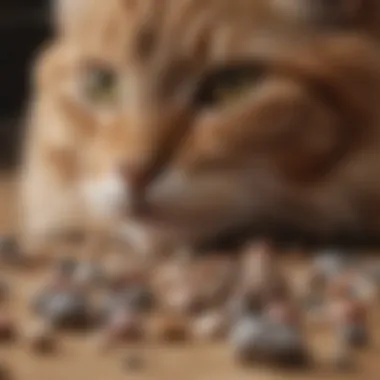
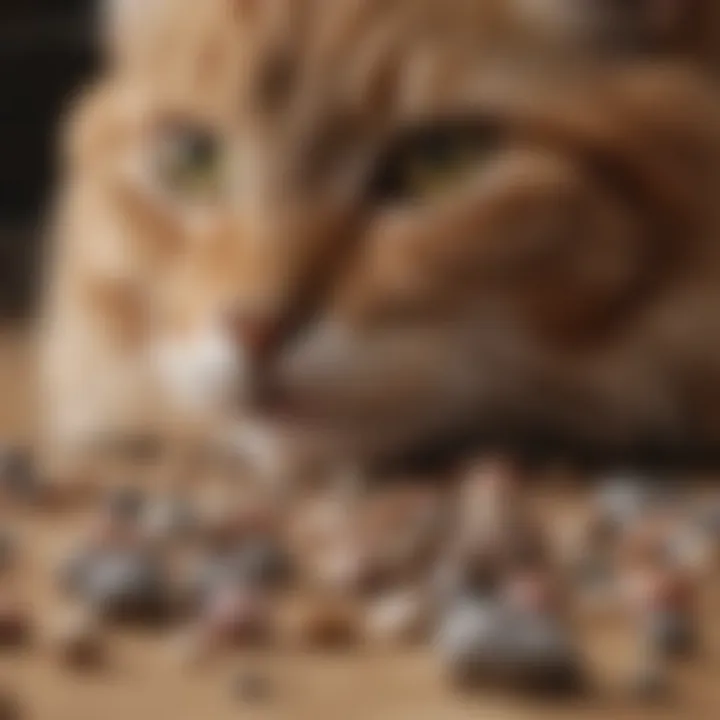
In summary, the materials used in cat nail scratchers have a direct impact on a cat's scratching habits and overall satisfaction. Understanding these options can help pet owners make informed decisions, ultimately leading to better outcomes in both feline health and home preservation.
Key Insight: Selecting the appropriate material is crucial for encouraging your cat to use the scratcher while ensuring they fulfill their natural scratching instincts.
Selecting the Right Cat Nail Scratcher
Choosing the appropriate cat nail scratcher is vital for ensuring your feline's health and contentment. A well-selected scratcher can deter unwanted scratching behaviors on furniture and carpets, making both the cat and owner happier. Understanding the specific elements that warrant consideration during selection can lead to numerous benefits, from enhanced scratching experiences to improved overall well-being.
Assessing Your Cat's Preferences
Every cat is unique in its behavior and preferences. When selecting a nail scratcher, observe how your cat interacts with different surfaces. Some cats prefer vertical scratching while others may like a horizontal approach. The material also plays a part; some cats respond well to sisal, while others favor cardboard.
It's beneficial to provide various options, allowing your cat to choose what suits them best. Doing so not only encourages scratching at designated spots but also enhances your cat's satisfaction and happiness.
Space Considerations for Your Home
Space is another significant aspect in selecting a nail scratcher. The layout of your home should influence whether you select a freestanding, wall-mounted, or multi-level design. If living in a small apartment, a compact vertical scratcher might be ideal. Conversely, if you possess more square footage, consider a larger multi-level structure that offers additional playtime opportunities.
Always think about the location of the scratcher. Placing it near your cat’s favorite resting area or near where they currently scratch can encourage use and help redirect their behavior positively.
Durability and Cost Factors
When investing in a cat nail scratcher, durability should not be overlooked. A scratcher made with robust materials can withstand heavy use, making it a worthwhile investment. Different products vary significantly in price based on the materials and craftsmanship involved. Generally, more expensive items tend to last longer, but it's also useful to read customer reviews and testimonials. This can provide insights into how well a particular scratcher holds up in real-world situations.
Overall, being mindful of durability and cost can yield a rewarding scratching experience for your cat while also being cost-effective in the long run.
Key takeaway: Selecting the right cat nail scratcher requires careful consideration of your cat's preferences, your living space, and cost versus durability.
Setting Up the Cat Nail Scratcher
Setting up a cat nail scratcher correctly is crucial for ensuring its effectiveness and promoting healthy scratching behavior in felines. The right setup not only encourages cats to use the scratchers instead of your furniture but also supports their natural instincts. Proper placement and encouragement strategies can significantly enhance the interaction between cats and their scratchers.
Optimal Placement in the Home
When deciding where to place a cat nail scratcher, consider your cat's habits. Cats often prefer scratchers in areas they frequent. Common spots include near sleeping areas, favorite lounging spots, or places where they usually scratch. Positioning scratchers nearby encourages use. Additionally, observe your cat’s scratching habits. If they tend to scratch certain furniture or areas, placing the scratcher nearby can redirect that behavior.
Another factor to think about is the type of scratcher. Vertical scratchers typically appeal to cats that enjoy climbing and stretching, while horizontal scratchers may be favored by those who like to lie down. Align the scratchers with these preferences to optimize your cat's engagement.
Key Considerations for Placement:
- Visibility: Make the scratcher easily visible to your cat.
- Accessibility: Ensure it’s easy for them to reach, especially for older or less mobile cats.
- Stability: Secure the scratcher in a way that it doesn’t wobble, which could deter use.
Placing multiple scratchers in different locations may also be beneficial, especially in homes with more than one cat. This reduces territorial disputes and encourages healthy scratching behavior across all pets.
Encouraging Use Through Positive Reinforcement
Positive reinforcement can be an effective technique in getting your cat to use the scratcher. When your cat uses the scratcher, reward them with treats or affection. This creates a positive association with the scratcher, encouraging them to return.
Try to be consistent with the rewards, providing them immediately after your cat interacts with the scratcher. Over time, your cat will learn to associate the scratcher with positive outcomes.
Tips for Positive Reinforcement:
- Treats: Keep some cat treats near the scratcher for immediate rewards.
- Praise: Use a gentle and enthusiastic voice to praise your cat when they use the scratcher.
- Play: Engage in play near the scratcher to encourage your cat to explore it during fun activities.
Incorporating these methods into your routine not only increases the chances of usage but builds trust between you and your cat, fostering a better environment for both you and your pet.
Maintaining Cat Nail Scratchers
Maintaining cat nail scratchers is an essential practice for cat owners. These scratching posts or alternatives play a vital role in ensuring the well-being of your feline companion. Regular upkeep not only enhances the longevity of the scratchers but also ensures they continue to meet your cat’s needs. Ultimately, a well-maintained nail scratcher contributes to a harmonious living environment, preserving both your furniture and your pet's natural behaviors.
Regular Inspection for Wear and Tear
It is crucial to regularly inspect your cat's nail scratchers for signs of wear and tear. Over time, scratchers may become frayed or damaged, which can affect their functionality. Cats may lose interest in using a scratcher that no longer serves its purpose effectively. Check for broken pieces, detached parts, or rough edges that could pose a risk of injury.
Benefits of regular inspection include:
- Enhanced Safety: Ensure the scratchers are safe for your cat to use.
- Improved Engagement: Keep your cat interested in using the scratchers.
- Cost-Effective: Identifying issues early can reduce the need for replacement.
During the inspection, assess if your cat is using the scratcher regularly. If not, it might indicate a need for replacement or repair.
Cleaning Procedures and Recommendations
Cleaning your cat’s scratchers should not be overlooked. Dust, dirt, and even small particles can accumulate on their surfaces. This buildup not only lessens the appeal of the scratchers but could also affect your cat’s health. Regular cleaning helps to maintain hygiene and ensures the scratchers remain a favorable option for your cat.
Here are some recommended cleaning procedures:
- Vacuuming: Use a vacuum or lint roller to remove loose debris and hair.
- Spot Cleaning: For stains, dab with a damp cloth and mild detergent. Avoid harsh chemicals that could harm your cat.
- Disinfecting: Occasionally, disinfect the scratchers with a pet-safe cleaner to eliminate bacteria.
It is advisable to clean the scratchers at least once a month. However, if your cat uses it heavily, more frequent cleaning may be necessary. Keep an eye on the condition of the scratchers and clean accordingly for optimal use.
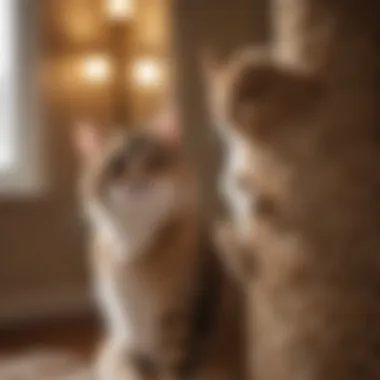
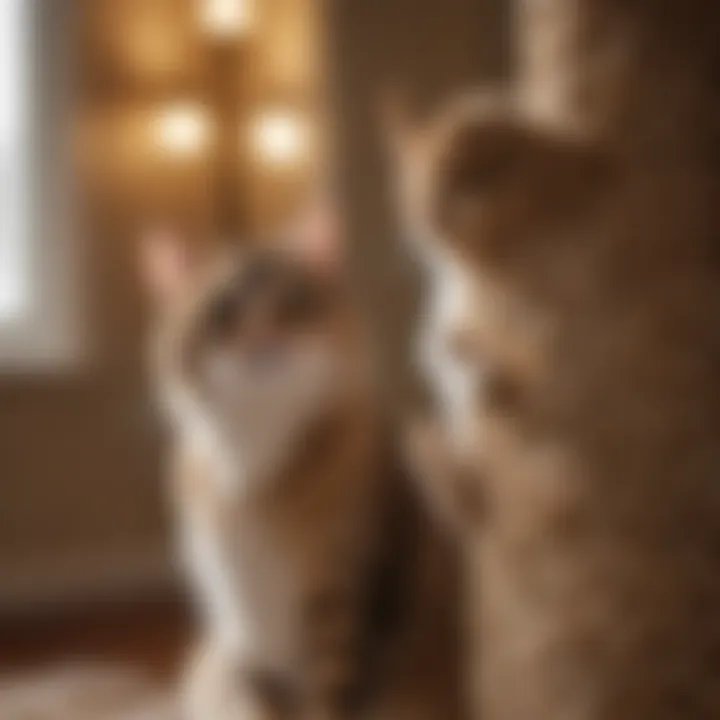
Tip: Always ensure that the scratcher is completely dry before allowing your cat to use it again.
Addressing Destructive Scratching Behavior
Destructive scratching behavior in cats can be a significant concern for pet owners. This section explores the reasons behind this behavior, as well as practical solutions to manage it. Recognizing the underlying causes and employing behavioral training can help mitigate the frustrations that come with a cat's scratching habits.
Understanding Underlying Issues
Before addressing a cat's scratching behavior, it is crucial to understand its roots. There are various reasons why a cat may scratch destructively. Cats are instinctively driven to scratch to mark territory, remove old claw sheaths, and stretch their muscles. Moreover, environmental factors can influence this behavior. Stress, anxiety, and boredom may lead cats to seek out inappropriate surfaces to scratch, such as furniture or walls. Understanding these underlying issues is essential for effective intervention.
Common factors contributing to scratching include:
- Lack of stimulation: Indoor cats, in particular, may lack sufficient physical and mental engagement, leading to frustration.
- Territorial instincts: Cats communicate through scent marking. Scratching helps them leave visual and scent marks in an area.
- Changes in environment: New pets, moving to a new home, or altered routines can make a cat feel insecure, prompting them to scratch.
By identifying these triggers, owners can devise strategies that address the root of the problem rather than merely the symptoms.
Behavioral Training Techniques
Once the underlying issues are identified, behavioral training can be implemented to redirect a cat’s scratching habits. It is important to approach this with patience and consistency. Here are some effective techniques:
- Provide appropriate alternatives: Invest in various types of cat scratchers that cater to your cat's preferences. Position these scratchers in areas where your cat already tends to scratch.
- Use positive reinforcement: Encourage your cat to use their scratcher by offering treats, praise, or playtime when they engage with it. This creates a positive association with the scratching act.
- Discourage unwanted behavior gently: If you catch your cat scratching furniture, redirect them without punishment. You can gently guide them to the scratcher instead.
- Use deterrent sprays: Some owners find success with safe, cat-friendly deterrent sprays on furniture. This can help create an aversion to inappropriate surfaces.
"Redirecting a cat’s scratching behavior takes time and consistency, but with the right approach, you can foster positive habits."
By understanding the reasons behind your cat's scratching and implementing training techniques, you can create a more harmonious home environment. This leads to a better quality of life for both the cat and the owner.
Psychological Factors Influencing Scratching Habits
Scratching is not just a physical action for cats; it serves deeper psychological needs. Understanding these factors is crucial for cat owners wanting to foster a harmonious living environment. The right scraping options can address these tendencies, leading to a happier, more balanced pet. This section explores two key aspects: territorial marking and stress management, both of which are fundamental in interpreting a cat's scratching behavior.
Territorial Marking and Scratchers
Cats are naturally territorial animals. Scratching is a way for them to mark their territory. When a cat scratches, it leaves both a physical mark and deposits scent from glands in its paws. This is important for establishing boundaries in their living space. Providing adequate scratching surfaces can meet this instinctual need.
Offering multiple types of scratchers in different areas can reduce territorial disputes, especially in multi-pet households. Encouraging a cat to use designated scratchers reinforces its territory while protecting household items like furniture. It is crucial to choose scratchers that suit your cat's preferences, whether they prefer horizontal or vertical surfaces; this will motivate them to engage in the desired behavior.
- Placement Matters: Position scratchers near places where your cat already scratches. This will encourage them to use these instead of your furniture.
- Variety in Height and Texture: Cats have individual preferences, so offering diverse scratchers can satisfy this instinct. Whether it be carpet, sisal, or cardboard, each material offers unique sensations.
Common Myths About Cat Nail Scratchers
The topic of cat nail scratchers often brings with it a number of misconceptions. Clearing these myths up is crucial for both the well-being of cats and the satisfaction of pet owners. Understanding these myths helps in making informed decisions about cat care. It's common for pets to exhibit certain behaviors, and misinterpreting these can lead to poor choices regarding their accessories and environment.
Debunking Misconceptions
One prevalent myth is that all scratching behavior is destructive. This is not true. Cats scratch for a variety of reasons, including stretching, marking territory, and keeping their claws healthy. It's vital to recognize that scratching serves critical functions in a cat’s life. By providing proper scratching surfaces, owners can redirect this instinctive behavior towards acceptable items, thus preserving furniture and household items.
Another misconception is that once a cat is introduced to a scratching post, they will automatically use it. However, this is often not the case. Cats are creatures of habit, and if they are accustomed to a certain type of scratcher or location, they may be resistant to changing their behavior. Owners should provide a variety of scratchers and observe which type their cat prefers.
In addition, some believe that scratchers are only for indoor cats. In reality, outdoor cats also benefit from scratching surfaces as they promote claw health and social signaling. Preventing cats from scratching can harm them both physically and mentally, leading to stress and behavioral issues.
The Role of Scratchers in Cat Welfare
Cat welfare is heavily linked to their environment and behaviors. Scratching plays an essential role in this. Properly designed nail scratchers not only meet physical needs but also contribute to mental well-being. Providing a suitable scratching surface can prevent unwanted habits and encourage healthy ones.
When a cat scratches, they engage in activities that help them maintain their claws and exercise their muscles. Regular scratching also reduces anxiety and promotes a sense of security. Furthermore, allowing cats to scratch in appropriate areas can strengthen the bond between the pet and the owner.
It is essential to provide various options for nail scratchers to improve overall cat happiness.
Owners should ensure that their pets have access to scratchers that are appropriate for their size and scratching style. This will ensure that the benefits of scratching are fully realized. Accessories such as catnip can further encourage their usage, making scratching a positive experience for both the cat and its owner.
In summary, dispelling these common myths helps enhance the quality of life for cats. Owners who understand the significance of scratching can provide better care and create a more harmonious home.
Finale: The Importance of Cat Nail Scratchers
Cat nail scratchers play a vital role in maintaining a cat's health and well-being. They are crucial for several reasons, including physical health, psychological balance, and preserving household furniture. Cats naturally have a strong scratching instinct. Providing a suitable outlet for this behavior not only keeps their claws healthy but also helps in preventing destructive scratching on sofas and other furniture.
Moreover, cat scratchers help in reinforcement of positive behaviors. By offering scratchers in various designs and materials, owners can promote healthy scratching habits. It is essential to select scratchers that align with a cat's natural preferences and characteristics. Understanding what types of scratchers resonate most with individual cats can enhance the overall cat-human relationship.
"A well-placed and appealing nail scratcher can significantly reduce anxiety and unwanted behaviors in felines, ensuring a harmonious home environment."
Cats, when allowed to express their instinctual behavior freely, are more likely to exhibit calmness and satisfaction. This is also beneficial for reducing stress levels over time. Investing in high-quality cat nail scratchers is not just a matter of convenience, but a commitment to the health and happiness of a beloved pet.
Summary of Key Takeaways
A few key points can be drawn from the discussion on cat nail scratchers:
- Physical Health: Regular scratching maintains claw health, allowing for natural care of claws.
- Behavioral Benefits: Proper scratching outlets reduce unwanted furniture damage and associated stress.
- Psychological Well-Being: Providing various scratcher types can cater to a cat's unique personality and needs.
- Positive Reinforcement: Using scratchers encourages healthy scratching and interactions between cats and their owners.
Understanding the significance of cat nail scratchers is a part of broader pet care that enhances the life of both pets and their owners.
Encouraging Responsible Pet Ownership
Being a responsible pet owner requires a commitment to understanding and catering to a cat's basic needs. This includes selecting the appropriate scratching posts and ensuring they are regularly maintained. Here are some practical steps:
- Educate Yourself: Take time to research different types of scratchers. Understanding your cat’s preferences is key.
- Invest in Quality: High-quality materials will not only last longer, but also provide better stimulation for your cat.
- Regular Maintenance: Inspect and clean scratchers. This promotes long-term use and hygiene in your home.
- Encourage Interaction: Engage with your cat while they use the scratchers. This helps strengthen the bond between pets and their owners.
By taking these steps, pet owners can ensure that they provide a conducive environment for their cats, fulfilling their basic instincts while also promoting responsible ownership. The benefits extend far beyond mere furniture protection; they contribute to a thriving household where both cats and humans can coexist peacefully.















